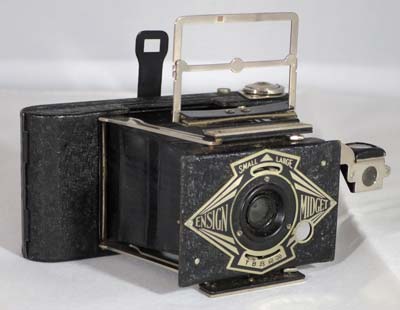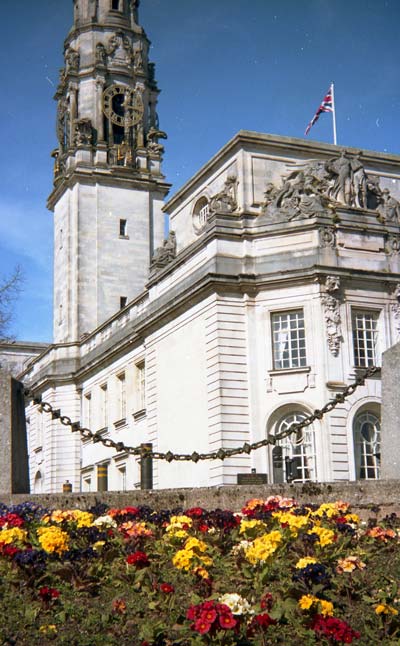Ensign Midget Model 33
Specification

| Manufacturer | : | Houghton-Butcher Manufacturing Co Ltd |
|---|---|---|
| Produced | : | 1934 - 1941 |
| Classification | : | Miniature |
| Body Type | : | Folding Strut |
| Construction | : | Metal |
| Film Type | : | E10 |
| Film Width | : | 35mm |
| Image Size | : | 1¼ x 1⅝ |
| No. of Images | : | 6 |
| Lens Type | : | Meniscus |
| Focus Type | : | Fixed |
| Focal Length | : | 55mm |
| Focal Range | : | 5ft - inf. |
| Aperture Type | : | Multihole |
| Apertures | : | f/11, f/16 |
| Shutter Type | : | Variable |
| Shutter Speeds | : | T, B, I(1/25, 1/50, 1/100) |
| Size Open (w x h x d) | : | 90 x 45 x 62 mm |
| Size Closed (w x h x d) | : | 90 x 45 x 18 mm |
| Weight | : | 145g |
Art Deco Credentials
![]()
![]()
![]()
![]()
Significant: Pronounced and self evident
- Produced during the main Art Deco period.
- Angular geometric design on front face.
- Chrome used on struts.
- Chrome used on film winder.
Description
Metal bodied (pressed steel) miniature folding camera with tapered supporting struts that fold away into the body. When extended, the struts are designed to hold the front panel in a rigid position. It features a simple viewfinder that folds out from the back and top, and also a brilliant finder that is normally closed for vertical views but can swing out when a horizonal view is required. It has two stops, one marked 'small' (f/16) and one marked 'large' (f/11). It has a T,B,I shutter with shutter speeds of 1/25, 1/50 and 1/100 s.
It is one of a set of midgets which have model numbers 22, 33 and 55. These numbers refer to the cost when new - ie. 22 shillings, 33 shillings and 55 shillings. A shilling is 5 pence in today's money. However, in 1935 this was a lot of money. 22 shillings=£75 today.
How to Use
Find the manual here.
This camera takes Ensign E10 film which is not available except as expired film. It is possible to roll 35mm film into old backing paper. Or you can make your own backing paper and cut your own film from 120.
If you don't want to bother with an exposure meter, follow the guide shown. It is based on the 'Sunny 16' rule. Film is so forgiving and will produce acceptable results even when overexposed by 2 or 3 stops or underexposed by 1 stop. Number of stops over or under exposure shown in brackets.
Remember that the exposure guide in the camera user manual may not be helpful as it is based on the use of old film with a low ISO value.
The tables assume that the sun is at least 30 degrees above the horizon - that's 10am - 5pm on a summer's day in the UK.
If you are not sure about the light level, err on the side of overexposure - i.e. assume the smaller f number.
Where there is a choice, a larger f number will give a larger depth of field.
For the slower speeds, you may need a tripod to stop blur through shake.
Using ISO 100/125 film
Green=Good
Amber=Acceptable
Red=Unacceptable
Small= f/16, Large=f/11
| Weather Conditions | Shadow Detail | Shutter Speed (s) | ||
|---|---|---|---|---|
| 1/25 | 1/50 | 1/100 | ||
 Sunny SunnySnow/Sand | Dark with sharp edges | f/16 (+3) | f/16 (+2) | f16 (+1) |
 Sunny Sunny | Distinct | f/16 (+2) | f16 (+1) | f/16 |
 Slight Overcast Slight Overcast | Soft around edges | f16 (+1) | f/16 | f/11 |
 Overcast Overcast | Barely visible | f/16 | f/11 | f/11 (-1) |
 Heavy Overcast Heavy Overcast | None | f/11 | f/11 (-1) | f/11 (-2) |
 Open Shade Open Shade/Sunset | None | f/11 (-1) | f/11 (-2) | f/11 (-3) |
Photographs taken with this Camera
Kodak Portra 160 film cut down to 35mm. Developed in Tetenal



